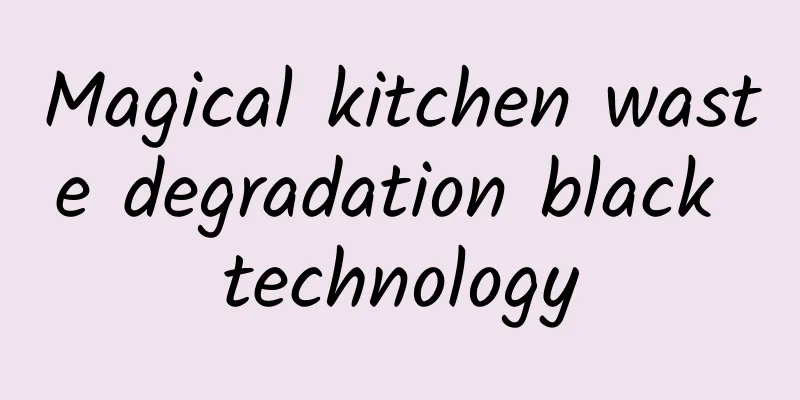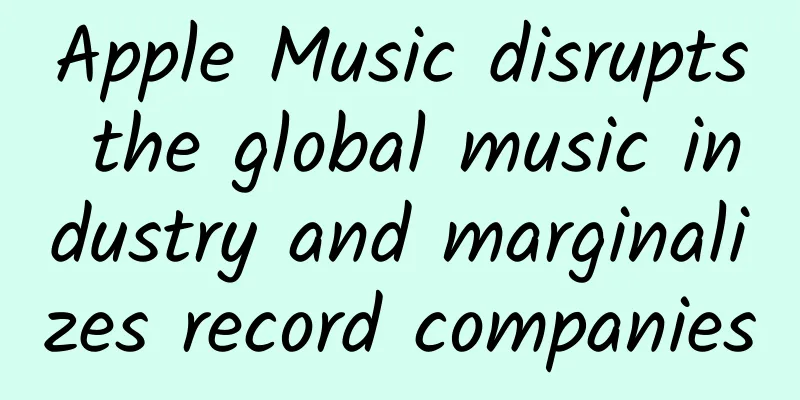Magical kitchen waste degradation black technology

|
This is what you have seen in kitchen waste... Such—— Still like this... Garbage classification is an innovation of the traditional extensive garbage collection and treatment method. It is a scientific management system for effectively disposing of garbage, avoiding environmental pollution, and promoting resource recycling. At present, my country has elevated garbage classification to a national system, and many places across the country, such as Beijing, Shanghai, Guangzhou and Shenzhen, have successively enacted legislation to promote it. The Ministry of Housing and Urban-Rural Development's "Notice on Comprehensively Carrying out Domestic Waste Classification in Cities at the Prefectural Level and Above Nationwide" requires that by 2025, cities at the prefectural level and above across the country should basically have established a garbage classification and treatment system. Kitchen waste refers to the waste generated in residents' daily life and food processing, catering services, unit catering and other activities, including discarded vegetable leaves, leftovers, leftovers, fruit peels, eggshells, tea dregs, bones, etc. Its main sources are family kitchens, restaurants, hotels, canteens, markets and other industries related to food processing. Kitchen waste contains extremely high moisture and organic matter, which is easy to rot and produce foul odors. The illegal collection and recycling of kitchen waste will threaten the environment and residents' health, but after proper treatment and processing, it can be converted into new resources. The high organic content allows it to be used as fertilizer and feed after strict treatment. It can also produce biogas for fuel or power generation, and the oil part can be used to prepare biofuels. After garbage classification, perishable garbage such as kitchen waste is decentralized and incremental, and the existing terminal processing capacity faces a large gap. The traditional centralized large-scale facility processing chain is long and the social investment burden is heavy. The use of local small-scale facilities for kitchen waste disposal can effectively reduce the source of domestic waste, save social costs, and avoid secondary pollution. It is a new model for solving the problem of kitchen waste treatment and there is huge social demand. The Institute of Applied Biotechnology and Equipment of Tianjin Institute of Advanced Equipment, Tsinghua University has been committed to the research and development and application of kitchen waste biodegradation technology for many years, and has proposed EDM environmentally friendly distributed kitchen waste equipment and biological solutions. Let the editor take you to learn about it... Research and Development The main methods of kitchen waste treatment at home and abroad include large-scale centralized incineration, landfill, anaerobic digestion (biogas), and distributed small kitchen waste treatment facilities. Distributed small facilities meet the characteristics of scattered kitchen waste generation, occupy a small area, require small investments, and reduce the total cost of waste treatment at the source. The social and economic benefits are very significant, and the market size has grown rapidly in recent years. At present, there are technical bottlenecks in the small-scale kitchen waste disposal facility industry: 1. High energy consumption of electric auxiliary heating The process route based on medium and high temperature drying uses auxiliary heating methods such as electric heating to dehydrate and dry kitchen waste to achieve reduction in volume, but it consumes a lot of energy and has high processing costs, which is not in line with the social sustainable development direction of low-carbon emission reduction. 2. The cost of leachate treatment is high and the sewage discharge does not meet the standards Because the composition of kitchen waste is complex and fluctuates greatly due to factors such as seasons and regional eating habits, process routes that include drainage and water treatment needs often have problems such as high sewage treatment costs and substandard emissions. In addition, the laying of drainage pipelines places high demands on the infrastructure of the treatment site. 3. Insufficient reduction and low degree of harmlessness The degradation of perishable components in kitchen waste is not complete, which can easily cause the treated products to rot again in a humid environment, thus causing secondary pollution, which does not meet the basic treatment requirements for complete harmlessness. Therefore, the innovative research and development of small modular and IoT-based intelligent equipment has great prospects for social and economic benefits. Technological innovation EDM Eco-friendly Distributed Microbial Food Waste Solution is an innovative food waste disposal solution that combines intelligent equipment and advanced microbial technology. It uses intelligent equipment to precisely control the treatment process, give full play to the efficient degradation function of microbial enzymes, and achieve harmless, reduced-volume treatment and resource utilization of food waste under conditions of no auxiliary heat and zero drainage. Technical advantages 1. No electric auxiliary heating, energy saving and environmental protection Microorganisms are used to degrade kitchen waste to generate heat spontaneously to maintain the temperature of the treatment process. There is no need for auxiliary heat and the energy consumption is low. 2. No drainage and no leachate There is zero drainage during the entire treatment process, no need for prior oil-water separation, no leachate generation, no risk of secondary pollution, no infrastructure burden, and flexible site selection. 3. No odor and completely harmless The perishable components in kitchen waste are degraded by microbial enzymes and converted into heat, carbon dioxide, water vapor and a small amount of biomass solid residue. There is no odor during the treatment process and the degradation products are safe and harmless. 4. Fast reduction speed and high reduction rate Garbage generated is processed on the same day, and the 24-hour kitchen waste degradation rate is ≥95%; when the equipment operates normally, the solid residue out of the warehouse cycle can reach more than one month, and the daily maintenance requirements are low. 5. Convenient control of smart IoT The equipment relies on the Internet of Things intelligent control system, real-time monitoring of the data platform, and remote control to reduce operating labor costs. 6. Shorten the processing chain and reduce social costs On-site treatment at the source eliminates the need for garbage collection and transportation, significantly reducing social costs. 7. Resource Utilization A small amount of biomass solid residue as the final product of the treatment can be used as raw material for organic fertilizer production, thus realizing resource utilization. 8. Wide range of applicable scenarios and flexible modes The equipment can be flexibly modularized and takes up a small area (for example, equipment with a processing capacity of 200kg/day occupies 7㎡), which can meet different needs in scenarios such as on-site processing (<1 ton/day) in individual units such as communities, government agencies and enterprises, and nearby processing (1 ton-50 tons/day) in units such as parks and streets. Application Value Research shows that with the annual growth of my country's food waste output and treatment rate, it is estimated that during the 14th Five-Year Plan period, the food waste treatment industry will have an additional investment of 20-50 billion yuan per year, with an annual compound growth rate of about 15%, and a total investment scale of 180 billion yuan. Distributed small-scale disposal facilities, as an effective way to treat food waste on-site, have grown rapidly in recent years. Taking Shanghai as an example, the Shanghai Municipal Greening and Beautification Administration plans that by 2025, nearly 3,000 tons/day of food waste will need to be treated through small-scale on-site facilities, accounting for about 1/3 of the total food waste treatment volume. The above-mentioned microbial degradation technology and equipment have been successfully applied to a variety of scenarios such as communities, airports, government agencies and corporate canteens. Through today's introduction, do you have a better understanding and knowledge of kitchen waste degradation technology and degradation equipment? Do you know that the non-similar impurities mixed in the garbage during the degradation process will affect the difficulty of the garbage treatment process and the quality of the organic fertilizer after degradation? Garbage classification has risen to a national system. Let us start with ourselves, do environmental protection, do a good job in basic garbage classification, and use technology to improve our lives. |
<<: Famous Ships in Chinese History (VIII)
>>: NASA releases latest map of electric currents around Mars, which accelerate atmospheric escape!
Recommend
Why are most organisms "symmetrical"?
Today, the biodiversity of the earth is very rich...
In fact, the frame is not the point. Is LeTV's super phone really super?
Accompanied by the huge controversy over "wh...
Sony H.Ear Go portable speaker review: All the connections you can think of are supported
In the past, when music was a luxury item, Sony w...
Tesla's new model can reach a speed of 320 kilometers per hour, accelerate from 0 to 100 kilometers in just 2 seconds, and is priced at about 790,000 yuan
Tesla will launch a new model, Model S Plaid, thi...
Why your phone needs a more powerful AI processor
Three years ago, AI became a new selling point fo...
10 Steps to Becoming a Professional iOS Developer — From Scratch
[[137409]] Want to get a piece of the mobile deve...
Screen burn-in is not a problem. Learn about the app that can save AMOLED screens.
Unconsciously, AMOLED screens have been able to c...
Chinese native dog, you are not even a breed!
What! The “Chinese native dog” is not a breed of ...
Do you think the "cracking" sound in the joints comes from the bones? | Illustrated Science
What is the "cracking" sound coming fro...
Customized development of jewelry mini program in Guangzhou, who is the best in jewelry mini program?
With the opening of various functions of mini pro...
A designer’s guide to artificial intelligence: basic concepts
When AlphaGo created by Google defeated the Go gr...
The "cold" war in the office: Girls are more likely to feel that the air conditioner is too cold
Review expert: Peng Guoqiu, deputy chief physicia...
Borrowing eggs to lay "chickens", China launches new charging pile technology to encourage car owners to use excess electricity to make a profit
Speaking of "reverse charging", this fu...
A popular blogger ate vegetarian food for 5 years and developed severe anemia. Why did this happen? Uncover the truth about vegetarianism
Is it healthier to be a vegetarian? In the eyes o...
China National Bureau of Statistics: Statistical Communiqué on National Economic and Social Development 2017
In 2017, under the strong leadership of the CPC C...









